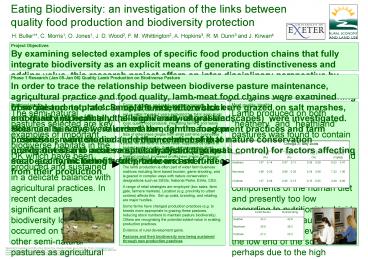Eating Biodiversity: an investigation of the links between quality food production and biodiversity - PowerPoint PPT Presentation
1 / 1
Title:
Eating Biodiversity: an investigation of the links between quality food production and biodiversity
Description:
In recent decades significant amounts of biodiversity loss has occurred on these ... Others are recognising the potential added-value in existing production practices. ... – PowerPoint PPT presentation
Number of Views:37
Avg rating:3.0/5.0
Title: Eating Biodiversity: an investigation of the links between quality food production and biodiversity
1
Eating Biodiversity an investigation of the
links between quality food production and
biodiversity protection
H. Buller1, C. Morris1, O. Jones1, J. D. Wood2,
F. M. Whittington2, A. Hopkins3, R. M. Dunn3 and
J. Kirwan4
Project Objectives By examining selected examples
of specific food production chains that fully
integrate biodiversity as an explicit means of
generating distinctiveness and adding value, this
research project offers an inter-disciplinary
perspective by positioning biodiversity and
environmental quality as an integral 'input' to,
and component of, food quality. The research is
investigating, through the combining of social
and natural science, the extent to which
environmental distinctiveness and quality
(specifically the biodiversity of grasslands) in
UK food production sites can be actively
valorised through the food product chain to
ensure the protection, maintenance and
enhancement of that natural distinctiveness and
quality but also to achieve similarly distinctive
quality food products and the socio-economic
benefits for producers and rural communities that
might accrue from their production
Phase 1 Research (Jan 05-Jan 06) Quality Lamb
Production on Biodiverse Pasture In order to
trace the relationship between biodiverse pasture
maintenance, agricultural practice and food
quality, lamb-meat food chains were examined from
pasture to plate. Sample farms, where stock are
grazed on salt marshes, moorland and heathland
(all significant natural landscapes) were
investigated. Botanical surveys were undertaken,
farm management practices and farm businesses
were studied (and their relationship to nature
conservation prerogatives) and meat samples
analysed (against a control) for factors
affecting meat quality, including health, taste
and shelf-life.
Botanical results The semi-natural pastures
selected are key examples of important biodiverse
habitats in the UK which have been produced and
sustained in a delicate balance with agricultural
practices. In recent decades significant amounts
of biodiversity loss has occurred on these and
other semi-natural pastures as agricultural
practices (and subsidy patterns) have changed (a
quarter of heathlands were lost in England, Wales
and Scotland between 1947 and 1980). Botanical
data collected demonstrates that grazing
management is producing pastures of high
botanical quality Heathery dominated vegetation
exhibits three predominant community types i)
Calluna vulgaris, Galium saxatile,
Rhytidiadelphus squarrosus, Agrostis stolonifera,
Deschampsia flexuosa, Vaccinium myrtillus
dominant (NVC H10 Calluna vulgaris - Erica
cinerea heath). ii) Trichophorum cespitosum,
Erica tetralix, V. myrtillus, Sphagnum
capillifolium, Narthesium ossifragrum dominant
(NVC M15 Trichophorum cespitosum - Erica tetralix
wet heath). iii) V. myrtillus, D. flexuosa,
Polytrichum commune, G. saxatile, Potentilla
erecta dominant (NVC H18 Vaccinium myrtillus -
Deschampsia flexuosa heath). Moorland dominated
vegetation with two predominant community
types i) Eriophorum vaginatum, D. flexuosa, C.
vulgaris, V. myrtillus, Rubus chamaemorus, S.
capillifolium, Empetrum nigrum, G. saxatile
dominant (NVC M19b Calluna vulgaris - Eriophorum
vaginatum blanket mire, Empetrum nigrum
sub-community). ii) R. squarrosus, N. stricta, G.
saxatile, Luzula multiflora, Agrostis vinealis,
D. flexuosa, F. ovina, V. myrtillus, P. erecta
dominant (NVC U5 Nardus stricta - Galium
saxatile grassland).
- Farm practices and land use management
- All the quality lamb production systems studied
have been set up within the last 7 years
motivated by fall in agricultural incomes, 2001
FMD outbreak, business opportunities for local,
quality food products, integrating farming and
nature conservation. - Size of enterprises ranges from small part-time
businesses to substantial businesses with on-farm
meat processing plants. All sell lamb at added
value, supported by claims of highest product
quality. Specific claims are made about links
between the biodiverse pastures and the quality
of the finished product. Increased profits have
made a difference to farm business
sustainability. - The lamb production is often part of wider farm
business matrices including farm based tourism,
game shooting, and is geared in complex ways with
nature conservation designations such as SSSIs,
National Parks, ESAs, CSS. - A range of retail strategies are employed (box
sales, farm gate, farmers markets). Location
(e.g. proximity to urban centres) affects this.
Set up costs, branding, and retailing are major
hurdles. - Some farms have changed production practices
(e.g. to breeds more appropriate to grazing these
pastures, reducing stock numbers to maintain
pasture biodiversity). Others are recognising the
potential added-value in existing production
practices. - Evidence of rural development gains.
- Pastures and their biodiversity now being
sustained through new production practices
Meat quality Health Lamb produced on both
heathery and heathland pastures was found to
contain high levels of omega 3-polyunsaturated
fatty acids and Vitamin E which are both
considered to be important components of the
human diet and presently too low according to
nutritionists. Lipid oxidation, which causes
rancid flavours at a high level, was at the low
end of the scale, perhaps due to the high
antioxidant (Vitamin E) concentrations in grazing
lambs. Meat quality
Taste Testing at Bristol of grilled loin chops
from sample lambs by a trained taste produced
results which showed higher liking scores to
the control samples.
1 Department of Geography (and CRR), Amory,
Rennes Drive, University of Exeter, Devon, EX4
4RJ. E-mail H.Buller_at_exeter.ac.uk 2 Division of
Farm Animal Science, Department of Clinical
Veterinary Science, University of Bristol,
Langford, North Somerset, BS40 5DU 3 Institute
of Grassland and Environmental Research, North
Wyke Research Station, Okehampton, Devon, EX20
2SB 4 CCRU, University of Gloucestershire,
Dunholme Villa, Park Campus, Cheltenham,
Gloucestershire, GL50 2RH

